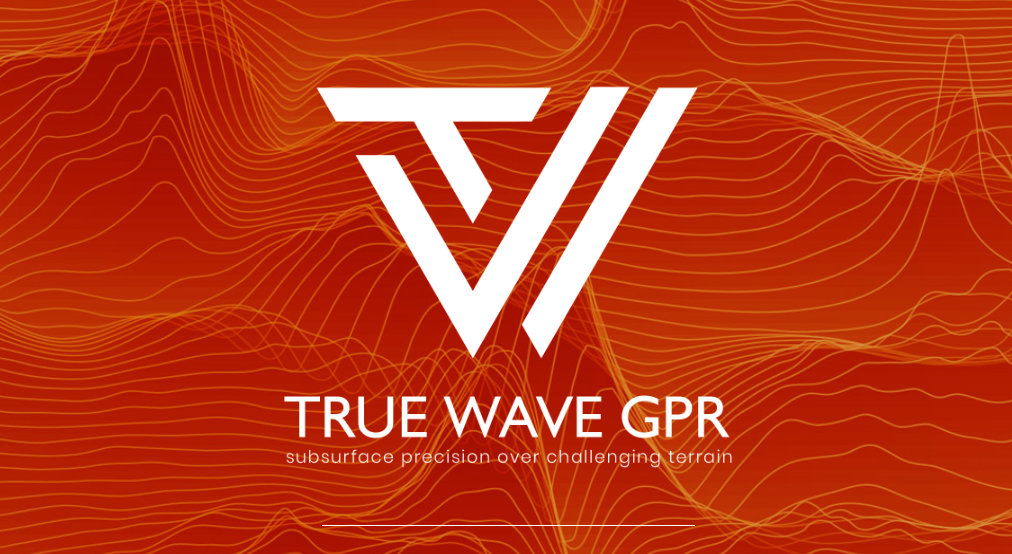
Objectives of the service
The TruewaveGPR project aims to advance ground-penetrating radar (GPR) technology by addressing the challenges of surveying subsurface assets, particularly utilities, in undulating and difficult-to-access terrains. Unlike traditional GPR systems that are limited to flat ground, TruewaveGPR integrates a modular system consisting of a Global Navigation Satellite System (GNSS), an inertial measurement unit (IMU), and an advanced data collection system. This modular design enhances the accuracy, efficiency, and versatility of existing GPR units by compensating for variations in terrain.
The IMU works in combination with GNSS data to determine the precise angular position of the GPR antenna during surveys. This ensures that subsurface imaging remains accurate even over challenging terrains with features such as trees, buildings, or slopes. TruewaveGPR’s software automates the integration of GNSS, IMU, and GPR data, producing accurate three-dimensional subsurface images fully compensated for terrain variations.
By removing the need for separate topographical surveys and reducing post-processing time, TruewaveGPR cuts survey time by up to 50% while improving accuracy. This innovation encourages the use of GPR in terrains previously deemed too costly or time-consuming to survey. The system’s capability to provide results in reduced time, empowers clients with actionable insights, enhancing safety, efficiency, and decision-making across industries reliant on subsurface imaging.
Users and their needs
PBU (UK) Ltd. will collaborate with critical infrastructure clients across all utility domains to help future-proof their assets, ensuring they can continue delivering essential services to their customers.
TruewaveGPR technology provides vital data to support preventative maintenance plans, asset renewal programs, and enhanced safety, health, environment, and quality (SHEQ) standards in the construction industry. By offering actionable insights, TruewaveGPR also reduces unforeseen costs, delivering substantial savings for infrastructure projects.
The technology offers a streamlined "One Stop Shop" process for various surveys, including topographical, undulating terrain, and localized subsurface investigations. TruewaveGPR is designed to meet the needs of the UK infrastructure market, offering timely, efficient solutions accessible via a user-friendly web interface.
Infrastructure forms the backbone of a nation’s economy, encompassing fixed installations like roads, bridges, and utility networks that keep essential services, such as power, water, and transportation, operational. In rail infrastructure, which includes earthworks, and track supporting infrastructure, TruewaveGPR delivers unprecedented insights, offering the UK rail industry data and capabilities it has never had before.
Service/ system concept
TruewaveGPR provides advanced subsurface imaging to locate existing assets and plan routes for infrastructure projects, such as those by Balfour Beatty VINCI, AMCOGIFFEN, and Excalon. These services are essential for utility diversions and new infrastructure installations, improving route planning by detecting and identifying subsurface features that could impede progress, such as buried debris or unidentified utilities.
Subsurface imaging also supports site planning for directional drilling, excavation, or construction activities. By identifying utilities, buried obstacles, or other subsurface features, TruewaveGPR enables informed decisions that minimise delays and risks, ensuring projects proceed efficiently and safely.
TruewaveGPR offers two distinct service types to meet diverse project needs:
Off-Road Surveys: Utilizing the TruewaveGPR system integrated with a 34-antenna array mounted on a vehicle, this configuration is designed for large survey areas, enabling square kilometers of undulating terrain to be mapped efficiently in a single day.
Local Surveys: Using TruewaveGPR with a manually operated two-antenna Cobra system, this setup is ideal for smaller areas or locations where vehicle access is restricted due to obstacles or terrain.
Most surveys involve both flat and undulating terrains, with the flexibility to deploy either or both configurations as required. TruewaveGPR's automated processing delivers results promptly, enabling much larger areas to be surveyed compared to traditional GPR services.
Key customers for these services include Balfour Beatty VINCI, AMCOGIFFEN, and Excalon, reflecting the system’s value in improving safety, efficiency, and decision-making for major infrastructure projects.
Space Added Value
The GNSS receiver utilised by TruewaveGPR leverages GPS and Galileo systems to determine the precise position of the radar unit. During pilot demonstrations, the system's sub-decimetre accuracy has been successfully validated, confirming its ability to calculate the radar unit's trajectory with precision. This accuracy is critical for determining the angular position of the antenna in combination with IMU data during post-processing, without reliance on external references like the Earth's magnetic field, which can exhibit significant spatial variation.
The use of real-time kinematic (RTK) positioning has proven effective in reducing post-processing time and ensuring seamless data integration for TruewaveGPR surveys. RTK is also cost-effective, particularly for the projects planned during the first two years of commercialization, where RTK networks are anticipated to be widely accessible. In cases where network RTK is unavailable or less feasible, such as in remote or challenging environments, alternative methods, including precise point positioning (PPP) or PPP-RTK, can be deployed.
The GNSS receiver enables precise translational positioning, which is integrated with IMU and GPR data to create accurate 3D datasets and visual representations of the subsurface. This validated approach eliminates the inefficiencies of traditional methods, such as map grids, which are time-consuming and lack the capability for automated integration.
The TruewaveGPR system, with its proven accuracy and efficiency, provides a reliable and scalable solution for subsurface imaging, ensuring timely and actionable insights for a variety of applications. The sub-decimetre accuracy of the GNSS receiver was rigorously tested and successfully validated during the pilot operational phase, underscoring its readiness for full-scale deployment in diverse environments.
Current Status
The objective of this project was to develop and demonstrate the capabilities of TrueWaveGPR technology, addressing key challenges in ground-penetrating radar (GPR) applications, particularly in undulating terrains and complex subsurface environments. By integrating satellite positioning, inertial measurements, and advanced data processing algorithms, the project successfully created a cutting-edge solution that delivers highly accurate 3D subsurface imaging, improving efficiency and decision-making for clients across various industries.
TrueWaveGPR has already proven its value through a series of successful demonstrations and live projects. The technology has been utilized for high-profile contracts, including surveys for Balfour Beatty at HS2’s Coventry Main Compound and Network Rail at Belsize Park and Glasgow. These projects generated meaningful results, including CAD models, interactive visualizations, and cross-referenced imaging, contributing directly to customer workflows and delivering significant revenue. Furthermore, TrueWaveGPR has been featured in key industry presentations and exhibitions, such as Rail Live 2024, where its potential was showcased to a wide audience of stakeholders and industry professionals.
With work schedules already in place for 2024/2025, TrueWaveGPR continues to build on its momentum. Future plans, driven by key customers such as Network Rail, include developing the technology further for track inspection applications. This expansion will enable the system to address new challenges in rail infrastructure maintenance, offering enhanced safety, precision, and efficiency in trackbed inspections.
TrueWaveGPR stands as a transformative advancement in GPR technology, with its ongoing development and adoption marking a significant milestone in improving the accuracy and reliability of subsurface investigations. This project not only underscores the system’s commercial viability but also lays the groundwork for continued innovation and collaboration with industry leaders.
Prime Contractor(s)
Subcontractor(s)





